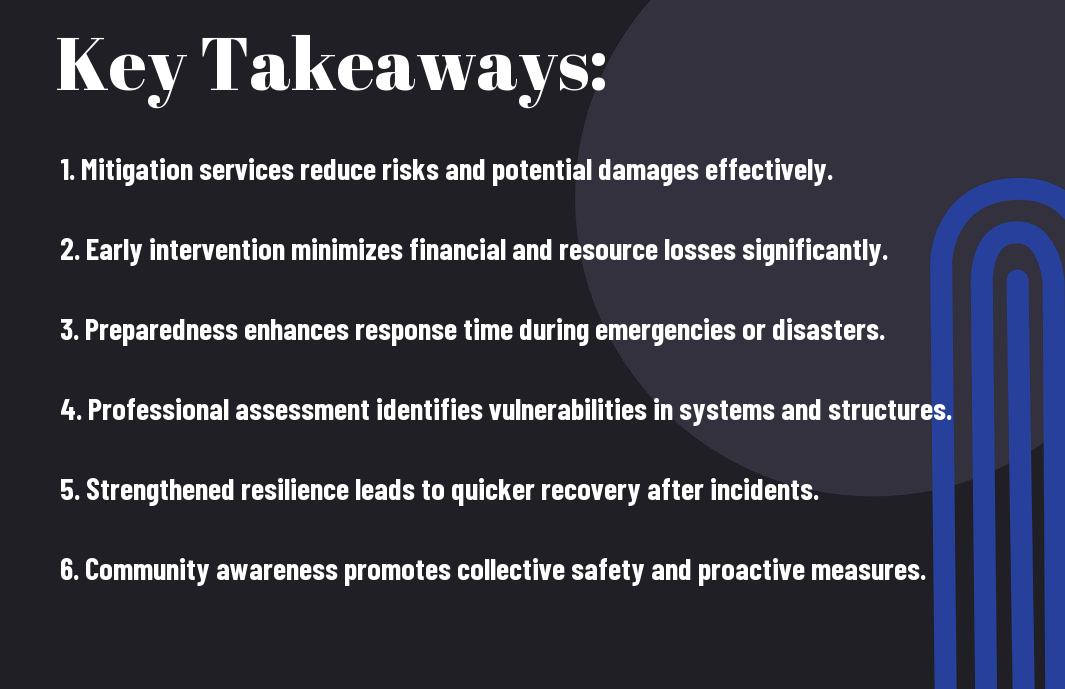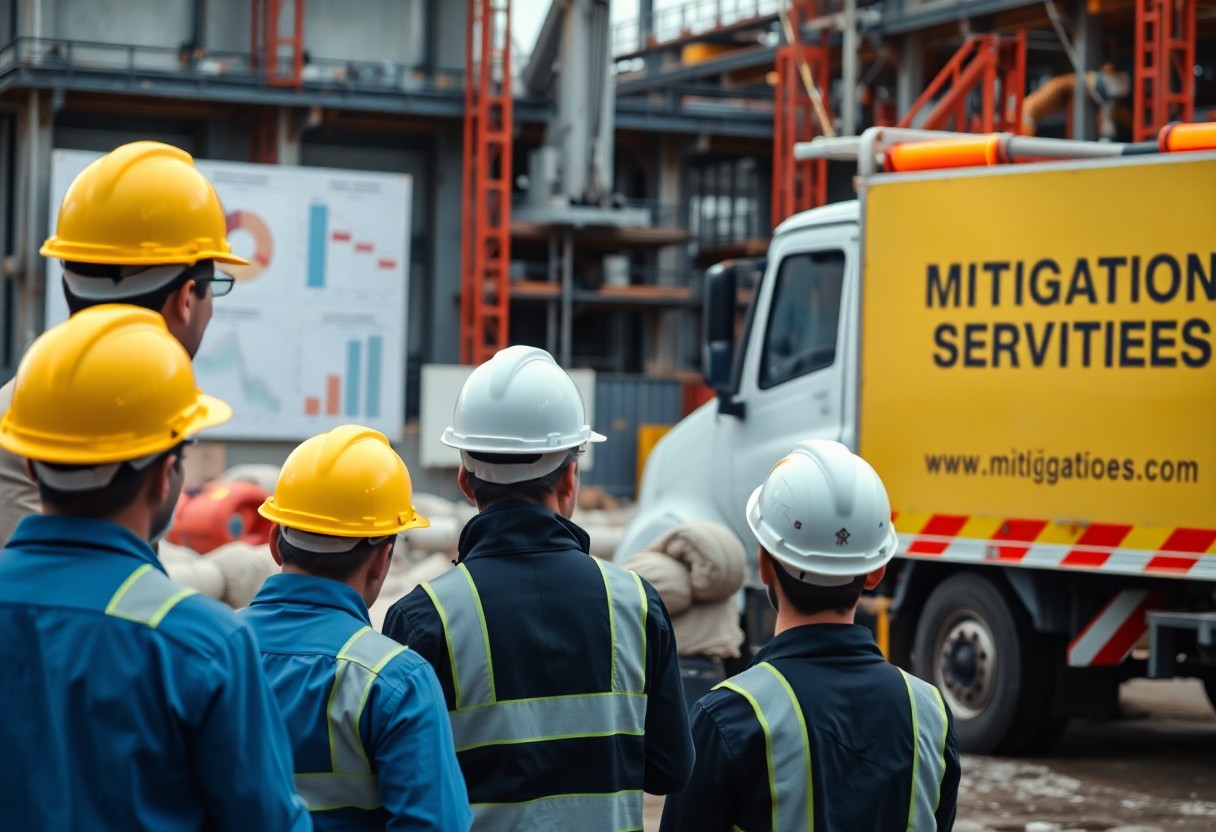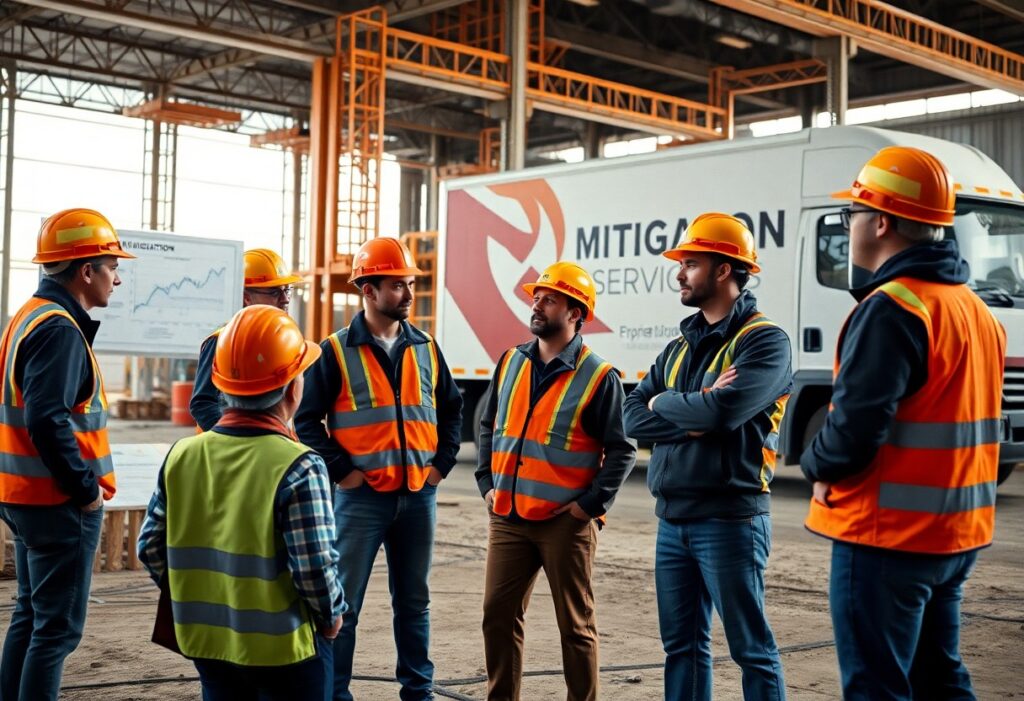Mitigation is your first line of defense against unexpected disasters that can disrupt your life and finances. By investing in water damage mitigation services, you can proactively identify vulnerabilities in your home or business, reducing the risk of potential losses. These services not only provide peace of mind but also help you save money in the long run by minimizing damage and ensuring swift recovery. You’ll be better equipped to protect your assets and maintain stability during challenging times, making mitigation an vital part of your overall risk management strategy.
Key Takeaways:
- Minimization of Damage: Mitigation services actively reduce the extent of damage during an incident, resulting in lower overall costs and quicker recovery times.
- Compliance and Safety: Implementing mitigation strategies ensures adherence to regulations and enhances the safety of individuals and properties, reducing potential liabilities.
- Long-term Resilience: Proactive mitigation measures build resilience against future incidents, helping communities and businesses withstand and adapt to challenges more effectively.
Understanding Mitigation Services
A comprehensive understanding of mitigation services is vital in today’s risk-prone environment. These services encompass strategies and practices designed to reduce potential hazards and the impact of disasters. By implementing effective mitigation measures, you can safeguard your assets, environment, and community, ultimately leading to enhanced safety and well-being.
What Are Mitigation Services?
Among the various strategies employed to combat potential hazards, mitigation services focus on preventing property damage and loss through proactive planning and interventions. These services may involve risk assessment, structural improvements, emergency preparedness training, and community outreach programs, all aimed at minimizing vulnerability and enhancing resilience.
Key Benefits of Mitigation
Before delving deeper into the world of mitigation services, it’s necessary to recognize their numerous advantages. Effective mitigation not only safeguards your assets but also significantly reduces recovery costs and the emotional toll associated with disasters. By prioritizing these services, you invest in a safer future, ensuring peace of mind for yourself and your loved ones.
Indeed, the key benefits of mitigation extend beyond immediate safety; they foster long-term resilience within your community. By implementing strong mitigation strategies, you can achieve substantial reductions in property damage, which directly translates to lower insurance premiums and faster recovery times after an incident. Furthermore, a well-prepared community enhances collaboration among residents and officials, creating a supportive network that thrives on safety and security. Embracing mitigation services ultimately empowers you to take control of your environment, transforming potential threats into manageable challenges.


Common Risks and Their Impact
It’s vital to understand the common risks you may face and their potential impacts on your life and property. By exploring mitigation strategies, such as Mitigation for Homeowners, you can better prepare and reduce the likelihood of facing severe losses.
Natural Disasters
Natural disasters can strike without warning, causing significant emotional and financial turmoil. Events like hurricanes, floods, and wildfires can devastate your home and community, highlighting the need for proactive mitigation efforts.
Economic Losses
For many, economic losses can be just as damaging as physical ones. When disasters hit, businesses may shut down, and personal income can plummet, leading to a ripple effect on your financial stability.
Risks associated with economic losses can create a heavy burden on your resources. Without proper mitigation, you may face declining customer demand, rising costs, and disrupted supply chains. These factors can paint a bleak picture for your financial future, underscoring the importance of preparing for unforeseen events to safeguard your investments and maintain your quality of life.
The Role of Mitigation in Risk Reduction
Not addressing potential risks through effective mitigation can lead to significant losses and hardships. Implementing strong mitigation strategies equips you with the tools to identify hazards, assess vulnerabilities, and take action before disastrous events occur. This proactive approach not only protects your assets but also fosters a culture of safety and resilience within your community.
Proactive Planning
Planning ahead is vital for reducing risks effectively. By anticipatively identifying potential threats and outlining actionable steps, you ensure that your response to emergencies is efficient and organized. This not only saves time but also minimizes confusion during crisis situations, allowing you and your community to recover more swiftly.
Community Involvement
Across neighborhoods, community involvement strengthens collective resilience against hazards. When you engage with your local community, you foster a shared responsibility for safety and disaster preparedness. Collaboration empowers everyone to identify risks, share resources, and create supportive networks, enhancing overall safety and preparedness.
Community involvement matters because it amplifies the impact of mitigation efforts. By actively participating in local initiatives, you help build strong relationships that lead to shared knowledge and increased awareness of potential hazards. Working together allows you to pool resources, conduct workshops, and organize drills, making you better equipped for emergencies. Ultimately, this unity transforms your community into a safer, more resilient environment where everyone plays a part in safeguarding their future.
Case Studies: Success Stories
Your understanding of the importance of mitigation services can be enhanced by looking at specific success stories. Here are some notable case studies that illustrate their effectiveness:
- Company A: Reduced water damage costs by 40% through comprehensive flood preparation.
- Company B: Achieved a 50% decrease in fire incident reports after implementing fire safety protocols.
- Organization C: Saved $1 million in losses by adopting proactive cyber security measures.
- Project D: Enhanced employee training led to a 60% reduction in workplace accidents.
Effective Mitigation Strategies
Between investing in advanced technology and conducting regular training sessions, you can develop effective mitigation strategies tailored to your needs. Identifying potential risks and addressing them promptly not only minimizes loss but also enhances operational efficiency.
Lessons Learned
After analyzing successful mitigation cases, you’ll find that adaptability and preparation are paramount. Implementing plans based on real-life lessons can lead to impressive outcomes.
Success in mitigation services often lies in the ability to adapt strategies based on previous experiences. By analyzing challenges faced and responses adopted, you can implement targeted improvements. For instance, organizations that prioritized employee training often witnessed significant drops in incidents, making it clear that investing in human resources is just as important as technology. Moreover, active participation and feedback from your team members contribute remarkably to strengthening your mitigation framework.
How to Implement Mitigation Services
Unlike many may assume, implementing mitigation services isn’t a one-time task but a continuous process. You can start by assessing your community’s vulnerabilities and needs, then prioritize actions accordingly. For more insights into the Importance of Hazard Mitigation, consider resources available in your area to ensure you make informed decisions.
Finding the Right Approach
On your journey to effective mitigation, tailor your strategies to fit your community’s unique circumstances and risks. Collaboration with local authorities, experts, and organizations can greatly enhance your approach.
Engaging Stakeholders
Finding the right people to involve in your mitigation efforts is key. Start by identifying local stakeholders, including government agencies, businesses, and public organizations that can help promote and support your initiatives.
With collaboration being *crucial*, actively engaging stakeholders not only amplifies your resources but also fosters a sense of *community ownership*. By working together, you can collectively enhance preparedness and resilience. Ensuring that your stakeholders understand their roles and the *positive impact* they can have will motivate more *effective participation*. Prioritize open communication and establish regular updates to keep everyone invested in your mitigation efforts.
The Future of Mitigation Services
To envision a safer future, mitigation services will continue to evolve and adapt to emerging challenges. As climate change and environmental threats grow more complex, innovative strategies and technologies will pave the way for more effective prevention strategies. This evolution means you’ll have access to better tools and resources that empower you to safeguard your investments and community.
Innovations on the Horizon
Innovations in mitigation services are set to revolutionize how you approach risk management. With advanced data analytics, AI-driven predictions, and smart technology, you will gain unprecedented insights into potential hazards, enabling you to make informed decisions faster and more effectively.
Building Resilience Together
Above all, building resilience is a collaborative effort that includes you, your community, and service providers. By working together, you can create a support network that enhances preparedness and response capabilities, reducing vulnerability to potential losses.
Due to the combined strength of community engagement and innovative practices, collective resilience will foster a safer future for everyone. When you participate in local initiatives, share your knowledge, and support each other, it enhances preparedness and fosters a spirit of collaboration. Every small action contributes to a larger impact, ultimately leading to a more resilient environment. You can encourage your neighbors and local leaders to invest in mitigation services, creating a stronger foundation for all.
To wrap up
From above, it’s clear that mitigation services play a vital role in helping you safeguard your property and assets. By actively identifying risks and implementing preventive measures, you can avoid significant losses down the line. Investing in these services not only enhances your peace of mind but also ensures a more secure environment for you and your loved ones. Take proactive steps today, and you’ll set yourself up for a safer tomorrow!
Q: Why are mitigation services important for businesses?
A: Mitigation services are vital for businesses as they help identify potential risks and vulnerabilities before they escalate into significant issues. By adopting these services, organizations can proactively address factors that might lead to operational disruptions, financial loss, or damage to reputation. Effective mitigation strategies enable companies to maintain continuity, protect their assets, and reduce the likelihood of incidents that could have dire consequences.
Q: How do mitigation services contribute to cost savings?
A: Mitigation services can lead to substantial cost savings for businesses by minimizing the impact of potential losses. By implementing preventive measures such as risk assessments and strategic planning, organizations can avoid costly repairs, legal liabilities, or insurance claims stemming from unforeseen events. Furthermore, investing in these services can lead to lower insurance premiums over time as insurers often reward companies that demonstrate a commitment to risk management and safety.
Q: In what ways do mitigation services enhance community resilience?
A: Mitigation services play a significant role in enhancing community resilience by fostering collaboration among stakeholders, including businesses, government agencies, and non-profit organizations. These services promote shared knowledge about risks and encourage collective action to address them. By improving preparedness and response strategies within communities, mitigation efforts contribute to a stronger social fabric and ensure that both businesses and residents are better equipped to withstand and recover from adverse events.

